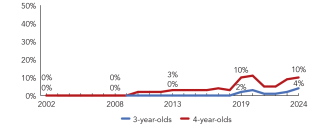
State of Preschool
Alaska
Access Rankings
Resource Rankings
Total Benchmarks Met
Overview

During the 2023-2024 school year, Alaska preschool enrolled 1,317 children, an increase of 277 from the prior year. State spending totaled $9,134,365, up $4,156,841 (84%), adjusted for inflation, since last year. State spending per child equaled $6,936 in 2023-2024, up $2,150 from 2022-2023, adjusted for inflation. Alaska met an average of 2.9 of 10 quality standards benchmarks.
What's New
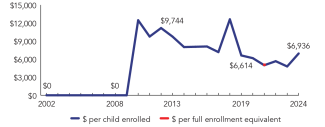
In May 2022, the Alaska State Legislature passed the Alaska Reads Act which provides more consistent and stable funding of early childhood programs starting July 1, 2023. The Alaska Reads Act includes a total of $3 million in grant money that is available to districts to develop preschool programs or to expand and improve upon existing programs. Programs can apply for a portion of the $3 million, to be spent over the course of three years. Districts that receive this competitive grant must work towards meeting
the Alaska Early Education Program Standards, which include components that meet Head Start Standards and other high-quality federal standards. Once a district has adopted the Standards and it is confirmed by the Alaska Department of Education and Early Development through an application-review-approve process, the district can claim their 4- and 5-year-old students as part of their Average Daily Membership (the state funding formula) at a rate of .5, starting the following fall.
Because of the Alaska Reads Act, the Alaska Early Education Program Grant (EEP) and the Alaska .5 ADM Approval Pre-K Program are included in the Yearbook for the first time this year. Starting with the 2023-24 school year, the state awarded EEP Grants to seven districts, on a 3-year cycle. These districts are working towards meeting Alaska’s Early Education Program Standards. One district, Anchorage, was included in the .5 ADM Approval Pre-K program, which includes stable funding through Alaska’s base student allocation formula, for 4- and 5-year-old pre-elementary students at .5 Average Daily Membership (ADM).
Background
Since the 1980s, Alaska has supplemented federal funding for Head Start programs in an effort to enhance school readiness and professional development and expand opportunities for children and families. During the 2023-2024 program year, the state provided $8,335,000 to support Head Start and Early Head Start programs in Alaska.
In 2009-2010, the state launched the Alaska PreKindergarten pilot program for school districts, now known as the Alaska Pre-Elementary program. In 2015, the state changed the way competitive grants were offered to include two types of grantees. Districts new to the program would apply for a 3-year Pre-Elementary Development Grant geared toward strategic planning to begin implementing or supporting existing Pre-Elementary goals. Previously funded grantees could apply for three-year renewal grants to support the program while the districts worked towards sustainability of the program once the state grant funding ended. Development grants were geared toward strategic planning to begin implementing or support existing Pre-Elementary goals until they could be switched to renewal grants.
Starting in the 2020-2021 school year, the Department posted a request for applications for a three-year Pre-Elementary Grant. Any school district was eligible to apply for this competitive grant. Seventeen districts were awarded a Pre-Elementary Grant for the three-year grant cycle starting on July 1, 2020, and ending June 30, 2023. A new application was posted in Spring of 2023, open to all school districts to either start a preschool program or continue and improve their existing program for children ages three to five years. Starting July 1, 2023, nine school districts were awarded the Pre-Elementary Grant. Dependent upon annual legislative funding of $3.2 million, the districts will receive grant funding through June 30, 2027. The financial support is part of an effort to promote school readiness and positive outcomes for participating 3-to-5-year-old children. The funds also offer admission to additional children and families whenever possible.
Insecure funding has affected program implementation and quality because the legislature provides the funding one year at a time. Funding for the Alaska Pre-Elementary program goes directly to school districts. Participating school districts may subcontract with Head Start programs or private early childhood programs and agencies.
-
Access
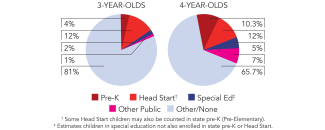
Total state pre-K enrollment 1,317 Special education enrollment, ages 3 and 4 1,092 Federally funded Head Start enrollment, ages 3 and 4 2,214 State-funded Head Start enrollment, ages 3 and 4 21 Resources
Total state pre-K spending $9,134,365 State Head Start spending $8,335,000 State spending per child enrolled $6,936 All reported spending per child enrolled* $6,959 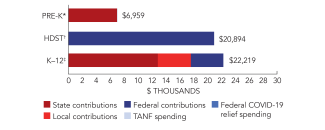
*Pre-K programs may receive additional funds from federal or local sources that are not included in this figure. †Head Start per-child spending includes funding only for 3- and 4-year-olds. ‡K–12 expenditures include capital spending as well as current operating expenditures.
-
Access
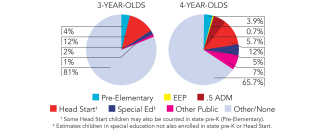
Total state pre-K enrollment 699 School districts that offer state program 31% Income requirement No income requirement Minimum hours of operation Determined locally Operating schedule Determined locally Resources
Total state pre-K spending $5,046,869 Local match required? No State Head Start spending $7,220 All reported spending per child enrolled* $7,263 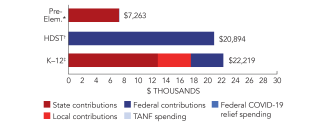
*Pre-K programs may receive additional funds from federal or local sources that are not included in this figure. †Head Start per-child spending includes funding only for 3- and 4-year-olds. ‡K–12 expenditures include capital spending as well as current operating expenditures.
Alaska Pre-Elementary Programs Quality Standards Checklist
| Policy | AK Pre-Elementary Requirement | Benchmark | Meets Benchmark? |
|---|---|---|---|
For more information about the benchmarks, see the Executive Summary and the Roadmap to State pages. | 2benchmarks met | ||
| Early Learning & Development Standards Benchmark | Comprehensive, aligned, supported, culturally sensitive | Comprehensive, aligned, supported, culturally sensitive | |
| Curriculum Supports Benchmark | Approval process | Approval process & supports | |
| Teacher Degree Benchmark | BA | BA | |
| Teacher Specialized Training Benchmark | Alaska Teaching Certificate | Specializing in pre-K | |
| Assistant Teacher Degree Benchmark | HSD | CDA or equivalent | |
| Staff Professional Development Benchmark | 6 credit hours/5 years (teachers only); PD plans (some public teachers & assistants) | For teachers & assistants: At least 15 hours/year; individual PD plans; coaching | |
| Maximum Class Size Benchmark | Determined locally | 20 or lower | |
| Staff to Child Ratio Benchmark | Determined locally | 1:10 or better | |
| Screening & Referral Benchmark | None | Vision, hearing & health screenings; & referral | |
| Continuous Quality Improvement System Benchmark | Structured classroom observations are required, but are determined locally; Data used for program improvement at the local level | Structured classroom observations; data used for program improvement | |
-
Access
Resources
Total state pre-K spending $2,393,897 Local match required? No State Head Start spending $25,199 All reported spending per child enrolled* $25,199 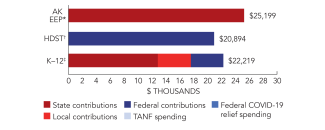
*Pre-K programs may receive additional funds from federal or local sources that are not included in this figure. †Head Start per-child spending includes funding only for 3- and 4-year-olds. ‡K–12 expenditures include capital spending as well as current operating expenditures.
Alaska Early Education Program Grant (EEP) Quality Standards Checklist
| Policy | AK EEP Requirement | Benchmark | Meets Benchmark? |
|---|---|---|---|
For more information about the benchmarks, see the Executive Summary and the Roadmap to State pages. | 4benchmarks met | ||
| Early Learning & Development Standards Benchmark | Comprehensive, aligned, supported, culturally sensitive | Comprehensive, aligned, supported, culturally sensitive | |
| Curriculum Supports Benchmark | Approval process & supports | Approval process & supports | |
| Teacher Degree Benchmark | BA (public); None (nonpublic) | BA | |
| Teacher Specialized Training Benchmark | ECE, Kindergarten | Specializing in pre-K | |
| Assistant Teacher Degree Benchmark | HSD (public); None (nonpublic) | CDA or equivalent | |
| Staff Professional Development Benchmark | 6 credit hours/5 years (public teachers only) | For teachers & assistants: At least 15 hours/year; individual PD plans; coaching | |
| Maximum Class Size Benchmark | 20 (3- & 4-year-olds) | 20 or lower | |
| Staff to Child Ratio Benchmark | 2:20 (3- & 4-year-olds) | 1:10 or better | |
| Screening & Referral Benchmark | Referrals | Vision, hearing & health screenings; & referral | |
| Continuous Quality Improvement System Benchmark | None | Structured classroom observations; data used for program improvement | |
-
Access
Resources
Total state pre-K spending $1,693,599 Local match required? No State Head Start spending $3,238 All reported spending per child enrolled* $3,238 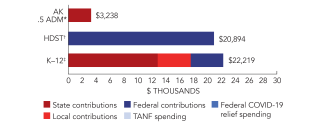
*Pre-K programs may receive additional funds from federal or local sources that are not included in this figure. †Head Start per-child spending includes funding only for 3- and 4-year-olds. ‡K–12 expenditures include capital spending as well as current operating expenditures.
Alaska .5 ADM Approval Pre-K Program Quality Standards Checklist
| Policy | AK .5 ADM Requirement | Benchmark | Meets Benchmark? |
|---|---|---|---|
For more information about the benchmarks, see the Executive Summary and the Roadmap to State pages. | 4benchmarks met | ||
| Early Learning & Development Standards Benchmark | Comprehensive, aligned, supported, culturally sensitive | Comprehensive, aligned, supported, culturally sensitive | |
| Curriculum Supports Benchmark | Approval process & supports | Approval process & supports | |
| Teacher Degree Benchmark | BA (public); None (nonpublic) | BA | |
| Teacher Specialized Training Benchmark | ECE, Kindergarten | Specializing in pre-K | |
| Assistant Teacher Degree Benchmark | HSD (public); None (nonpublic) | CDA or equivalent | |
| Staff Professional Development Benchmark | 6 credit hours/5 years (public teachers only) | For teachers & assistants: At least 15 hours/year; individual PD plans; coaching | |
| Maximum Class Size Benchmark | 20 (3- & 4-year-olds) | 20 or lower | |
| Staff to Child Ratio Benchmark | 2:20 (3- & 4-year-olds) | 1:10 or better | |
| Screening & Referral Benchmark | Referrals | Vision, hearing & health screenings; & referral | |
| Continuous Quality Improvement System Benchmark | None | Structured classroom observations; data used for program improvement | |